1. Ministry of National Defense (KR). 2012 Defense White Paper. Seoul, Korea: Defense Policy Division, Policy Planning Bureau;2012.
2. Byeon G, Jo SJ, Lee HW, Yim HW, Park JI. Development of a short form depression screening questionnaire for Korean soldiers. J Korean Med Sci. 2021; 36(27):e185. PMID:
34254472.

3. Shin YC, Kim SM, Kim H, Min KJ, Yoo SK, Kim EJ, et al. Resilience as a protective factor for depressive mood and anxiety among Korean employees. J Korean Med Sci. 2019; 34(27):e188. PMID:
31293112.

4. Oldenburg M, Baur X, Schlaich C. Occupational risks and challenges of seafaring. J Occup Health. 2010; 52(5):249–256. PMID:
20661002.

5. Jezewska M, Leszczyńska I, Jaremin B. Work-related stress at sea self estimation by maritime students and officers. Int Marit Health. 2006; 57(1-4):66–75. PMID:
17312695.
7. Iversen RT. The mental health of seafarers. Int Marit Health. 2012; 63(2):78–89. PMID:
22972547.
8. Lucas D, Mehaneze M, Loddé B, Jegaden D. Seasickness and its impact on researchers’ work on board French oceanographic vessels. Int Marit Health. 2020; 71(3):160–165. PMID:
33001426.

9. Carotenuto A, Molino I, Fasanaro AM, Amenta F. Psychological stress in seafarers: a review. Int Marit Health. 2012; 63(4):188–194. PMID:
24595974.
10. Allen P, Wadsworth E, Smith A. Seafarers’ fatigue: a review of the recent literature. Int Marit Health. 2008; 59(1-4):81–92. PMID:
19227741.
11. Williams RA, Hagerty BM, Yousha SM, Hoyle KS, Oe H. Factors associated with depression in navy recruits. J Clin Psychol. 2002; 58(4):323–337. PMID:
11920688.

12. Benson AJ, Barnes GR. Vision during angular oscillation: the dynamic interaction of visual and vestibular mechanisms. Aviat Space Environ Med. 1978; 49(1 Pt. 2):340–345. PMID:
304721.
13. Schmäl F. Neuronal mechanisms and the treatment of motion sickness. Pharmacology. 2013; 91(3-4):229–241. PMID:
23615033.

14. Hong S, Kim S, Park DH, Ryu SH, Ha JH, Jeon HJ. The mediating effect of insomnia on the relationship between panic symptoms and depression in patients with panic disorder. J Korean Med Sci. 2021; 36(9):e30. PMID:
33686808.

15. Altunayoglu Cakmak V, Gazioglu S, Can Usta N, Ozkorumak E, Ayar A, Topbas M, et al. Evaluation of temperament and character features as risk factors for depressive symptoms in patients with restless legs syndrome. J Clin Neurol. 2014; 10(4):320–327. PMID:
25324881.

16. Hwang KJ, Kim EH, Kim YJ, Hong SB. Frequency of depression and suicidality in patients with neurological disorders: epilepsy, Parkinson’s disease, and ischemic stroke. J Korean Neurol Assoc. 2016; 34(3):193–200.

17. Beck AT, Ward CH, Mendelson M, Mock J, Erbaugh J. An inventory for measuring depression. Arch Gen Psychiatry. 1961; 4(6):561–571. PMID:
13688369.

18. Beck AT, Steer RA, Garbin MG. Psychometric properties of the Beck Depression Inventory: twenty-five years of evaluation. Clin Psychol Rev. 1988; 8(1):77–100.

19. Zhang X, Sun Y. Motion sickness predictors in college students and their first experience sailing at sea. Aerosp Med Hum Perform. 2020; 91(2):71–78. PMID:
31980044.

20. Alcantara-Thome M, Miguel-Puga JA, Jauregui-Renaud K. Anxiety and motion sickness susceptibility may influence the ability to update orientation in the horizontal plane of healthy subjects. Front Integr Neurosci. 2021; 15:742100. PMID:
34594190.

21. Reason JT. Relations between motion sickness susceptibility, the spiral after-effect and loudness estimation. Br J Psychol. 1968; 59(4):385–393. PMID:
5719793.

22. Lackner JR. Motion sickness: more than nausea and vomiting. Exp Brain Res. 2014; 232(8):2493–2510. PMID:
24961738.

23. Leung AK, Hon KL. Motion sickness: an overview. Drugs Context. 2019; 8:2019-9-4.

24. Zhang LL, Wang JQ, Qi RR, Pan LL, Li M, Cai YL. Motion sickness: current knowledge and recent advance. CNS Neurosci Ther. 2016; 22(1):15–24. PMID:
26452639.

25. Liu W, Ge T, Leng Y, Pan Z, Fan J, Yang W, et al. The role of neural plasticity in depression: from hippocampus to prefrontal cortex. Neural Plast. 2017; 2017:6871089. PMID:
28246558.

26. Bigelow RT, Semenov YR, du Lac S, Hoffman HJ, Agrawal Y. Vestibular vertigo and comorbid cognitive and psychiatric impairment: the 2008 National Health Interview Survey. J Neurol Neurosurg Psychiatry. 2016; 87(4):367–372. PMID:
25886779.

27. Meltzer H. Serotonergic dysfunction in depression. Br J Psychiatry Suppl. 1989; 155(8):25–31.

28. Kapur S, Mann JJ. Role of the dopaminergic system in depression. Biol Psychiatry. 1992; 32(1):1–17. PMID:
1391289.

29. Nutt DJ. Relationship of neurotransmitters to the symptoms of major depressive disorder. J Clin Psychiatry. 2008; 69 (Suppl E1):4–7.
30. Drummond PD. Effect of tryptophan depletion on symptoms of motion sickness in migraineurs. Neurology. 2005; 65(4):620–622. PMID:
16116130.

31. Spinks AB, Wasiak J, Villanueva EV, Bernath V. Scopolamine for preventing and treating motion sickness. Cochrane Database Syst Rev. 2004; (3):CD002851. PMID:
15266468.

32. Held R. Exposure-history as a factor in maintaining stability of perception and coordination. J Nerv Ment Dis. 1961; 132(1):26–32. PMID:
13713070.

33. Ruckenstein MJ, Harrison RV. Motion sickness. Helping patients tolerate the ups and downs. Postgrad Med. 1991; 89(6):139–144.
34. Helling K, Westhofen M. Experimental studies of motion sickness on board of a research ship. HNO. 1994; 42(4):214–219. PMID:
8021156.
35. Cha JM, Kim JE, Kim MA, Shim B, Cha MJ, Lee JJ, et al. Five months follow-up study of school-based crisis intervention for Korean high school students who experienced a peer suicide. J Korean Med Sci. 2018; 33(28):e192. PMID:
29983694.

36. Lim AY, Lee SH, Jeon Y, Yoo R, Jung HY. Job-seeking stress, mental health problems, and the role of perceived social support in university graduates in Korea. J Korean Med Sci. 2018; 33(19):e149. PMID:
29736162.

37. Sohn BK, Park SM, Park IJ, Hwang JY, Choi JS, Lee JY, et al. The relationship between emotional labor and job stress among hospital workers. J Korean Med Sci. 2018; 33(39):e246. PMID:
30250411.

38. Woo SY, Kim HJ, Kim BR, Ahn HC, Jang BN, Park EC. Support from superiors reduces depression in Republic of Korea military officers. BMJ Mil Health. 2021; 167(6):378–382.

39. Chan G, Moochhala SM, Zhao B, Wl Y, Wong J. A comparison of motion sickness prevalence between seafarers and non-seafarers onboard naval platforms. Int Marit Health. 2006; 57(1-4):56–65. PMID:
17312694.
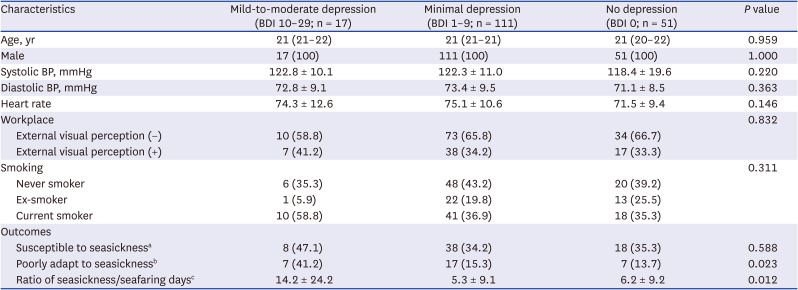
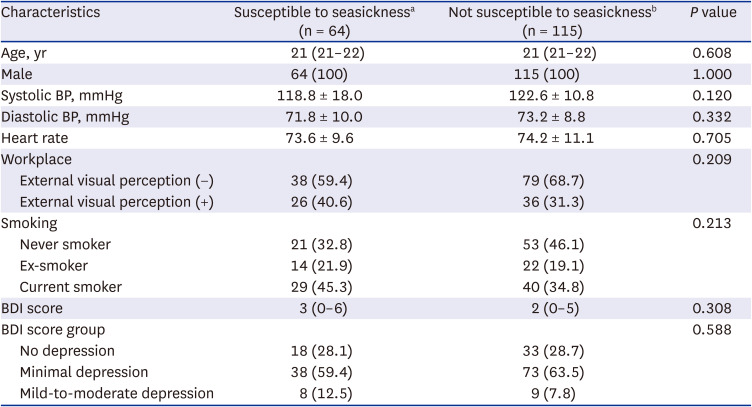
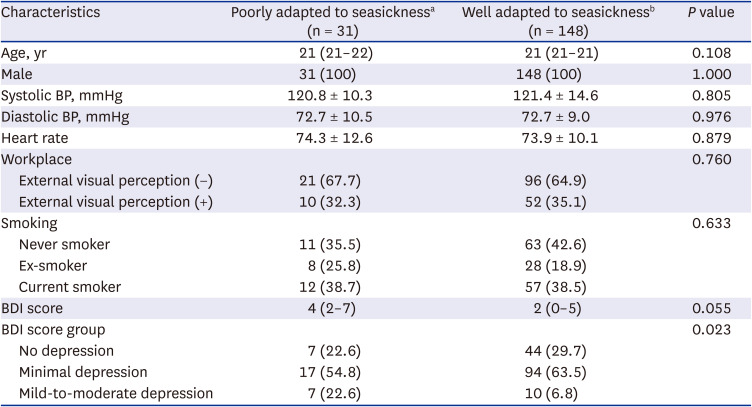
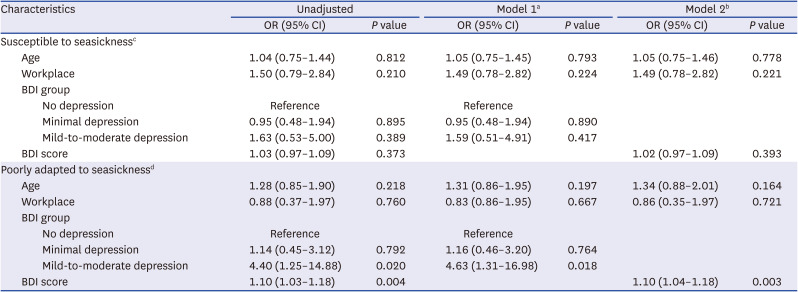




 PDF
PDF Citation
Citation Print
Print



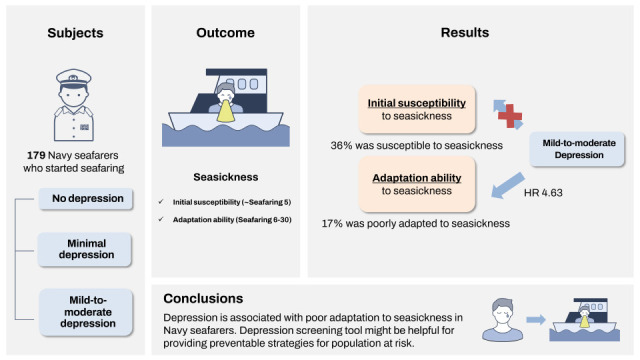
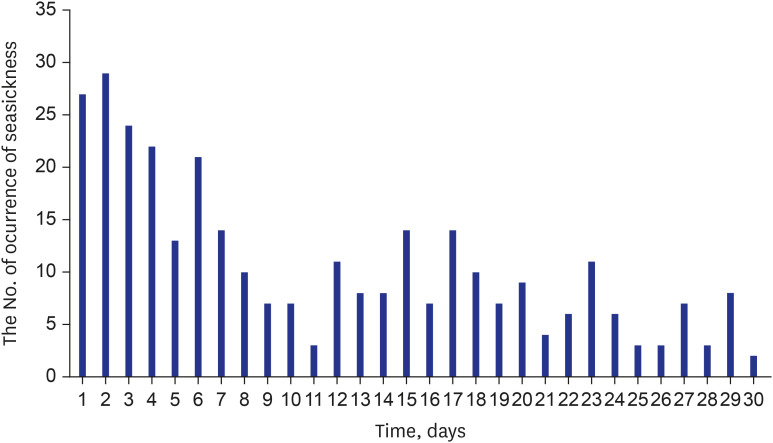
 XML Download
XML Download